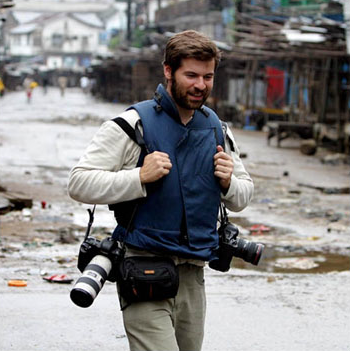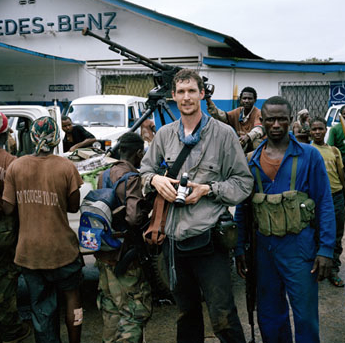 This year’s NAB was a BLAST of fun and of new products and announcements. While there were literally tens of thousands of new products beings launched – and almost as many companies vying for my and other people’s attention – for me this was the year of the CAMERA, as a slew of new cameras and corresponding footage were released. But what really made this the “Year of the Camera” for me – or what kept me focused on the new cameras was Zacuto’s “Great Camera Shootout” camera test results that they were screening during the trade show (Zacuto won an Emmy last year for their tests).
This year’s NAB was a BLAST of fun and of new products and announcements. While there were literally tens of thousands of new products beings launched – and almost as many companies vying for my and other people’s attention – for me this was the year of the CAMERA, as a slew of new cameras and corresponding footage were released. But what really made this the “Year of the Camera” for me – or what kept me focused on the new cameras was Zacuto’s “Great Camera Shootout” camera test results that they were screening during the trade show (Zacuto won an Emmy last year for their tests).
PLEASE NOTE: GO TO THE 3rd CAMERA SECTION BELOW FOR NEVER BEFORE SEEN FOOTAGE FROM THE SONY F3 with the S-LOG firmware update.
Zacuto collaborated with ASC DP Bob Primes to test all of the top of the line cameras in a series of in-depth tests that I found incredibly revealing – so much so that I asked them to do a second screening for me to which I invited a select few people who I thought NEEDED to see these tests. I look forward to writing about these tests within the next few weeks on this blog – and I’ll be talking a lot more in depth about what I saw then.
Please note that the results below (and my opinions) are based BOTH on my own personal experience with the cameras, and other shoots I’ve seen others do with the cameras – NOT JUST the Zacuto tests (ergo – while the Epic was not in the group tested by Zacuto/Primes) I have seen a fair share of Epic footage from a variety of sources. And I’ve shot the Mysterium X sensor a number of projects.
Below are some quick observations only (i.e. not empirical data). So here are my personal findings based on the two screenings, and my personal experience with the cameras AS WELL – in other words, this is in no way meant to be an in depth post on the cameras below (that will come later) but just a quick overview. And these opinions are based on what I’ve seen in the tests AND through other sources.
I. WINNER: ERGONOMICS & RESOLUTION (AND CLOSE TO ALL AROUND WINNER) – RED’s EPIC
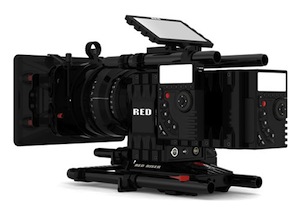
Pros: This is the camera everyone has been dreaming of. The form factor is simply put: perfect. When I mounted a Leica cine prime onto this camera – it was perfectly balanced for handheld work. I felt like I could go shoot an entire concert, a documentary, a portrait shot, or even a short film by myself – HANDHELD. No shoulder mounts, Steadicams etc… This felt like shooting with a Hasselblad Medium format camera. The fact that I would be shooting these at 5K didn’t hurt either. With Adobe’s CS5.5 Warp feature – the extra resolution will allow people to do handheld moves – that can look close to Steadicam work after processing (when output at 2K.) More on Warp another time… This is one of the – if not THE – hottest cameras to get right now. I heard a rumor today that NFL films purchased 150 of them… does that mean the end of film for NFL films? 150 is a lot of cameras if this rumor is true… The image quality is right up there with all other cameras – but none of them come in such a tight little package. The fact that this camera accepts PL, EF, and Nikon lens mounts is a plus, and the wonderful little wireless REDMOTE doesn’t hurt either. I saw Ted interact with the camera with his iPad – changing every setting, and even color curves live (and wireless) – IMPRESSIVE.
Cons: 1. The fact that EVERYONE wants one is a problem – it’s going to be awhile. That and the fact that RED and every other camera manufacturer is going to feel the effects of the Japan Tsunami in terms of the their parts supplies won’t help (expect EVERY camera manufacturer to have some substantial supply issues this year, not only were many plants hit by the Tsunami – but more importantly almost ALL of them had to shut down due to rolling blackouts… so everyone is behind.) Supply issues (whether w/ Red or Alexa or any manufacturer) is something to be considered seriously. It’s not just about getting your initial camera – but also about replacing it in case it gets lost/damaged… not easy when you’re trying to get your hands on the hottest camera in the world.
2. This is one of those “opinon” or “taste” things on a visual level. Having worked with the current Red MX chip in the RED ONE camera on a multitude of jobs I’ll say the following: the image is a bit too clean for me. I wish I saw more “grain/noise” in the image (Alexa has done this incredibly well.) Of course grain can be added in post (although as simple as that sounds, it’s yet another step in post – for example, the high end DaVinci Resolve I used on a recent project didn’t have that function, and we had to do a second pass to add “grain.”) Also – there is that golden area in the shadows that all cinematographers/photographers love. That area that is barely lit – I’d say in the 90%-95% shadow area. This is the only area where I don’t see this sensor performing as well as the Alexa for example. I’m being VERY nitpicky here.
NB: The Red One w/ MX sensor was used for the Zacuto test – NOT the Epic. That being said I have seen quite a bit of footage from the Epic and am basing my opinion on what I’ve seen in person, and in the Red projection booth at NAB.
II. WINNER OVERALL IMAGE QUALITY – ARRI’S ALEXA
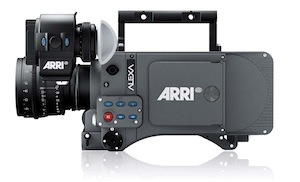
Pros: This was the best image quality I saw in Zacuto’s test. It seemed to excel in every single test over the competition (rolling shutter being the only one where other cameras such as the Phantom Flex excelled.) The image’s sharpness, color rendition, low light performance, shadow detail was tops. Most people love this camera’s user interface as well – menus etc are perfectly placed. It sees into the shadows like few other cameras do – and how the engineers handle noise with this camera is wonderful – making it appear more like “film grain” if you will. One of the big surprises for me in this camera test was how most of the cameras did a significantly (I do mean SIGNIFICANTLY) better job at seeing into the shadows than Kodak motion picture film (motion picture film is known for its ability to hold highlights – not dig into the shadows – most of us know that – but this test showed just HOW MUCH SO.) This is one stunning camera.
Cons: 1. Availability – this too is a camera that is in incredible demand – see issues w/ that mentioned w/ Epic above. 2. Only 2K – while I don’t feel the need for 4K – I’d love to have it in my pocket to use features such as Adobe’s Warp stabilization feature and for other VFX uses… to me resolution has less to do with 4K display, as what you can do with the image in post (just as w/ still images) 3. Price and size – while both are much lower than they were just a few years ago – a full setup w/ tax will come to more than $80K and on the Plus version of the camera will come to close to $95K+. And you won’t be handholding this camera all day like the Epic above. If I were to buy one camera today – I’d be going back and forth between the Epic and Alexa.
III. WINNER – SURPRISE SHOCKER IMAGE QUALITY to PRICE ratio- SONY’S F3
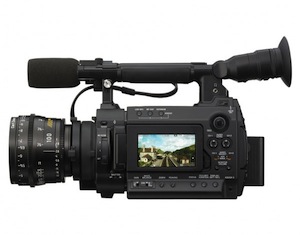
Pros: I really didn’t like the Panasonic AF100 (see below) and I must admit to having mad a snap judgment on the F3. But when I saw the test results – every single time the F3 came up, you could hear people making a variety of noises during the screening – everyone was surprised to see this camera perform right up there with the big boys on most tests. This is probably going to be the surprise camera of 2011. Given its price tag, weight and form factor – it might just become the darling of 2011 for many. The image quality was stunning. I can’t say this until I get a copy of the test results from Zacuto and look at the images side by side – but I have to say that it came very very close to the Alexa and Epic. And excelled in the low light/shadow areas.
And then – in comes S-log and you all just watch out… Zacuto’s tests didn’t have the benefit of S-log because it wasn’t available then. But somehow – at 2 O’Clock in the morning last Wednesday I became involved in another crazy test. Khalid Mohtaseb and Jonathan Bregel from Next Level Pictures got their hands on of the first Sony F3 cameras w/ the S-Log firmware update from Abel Cine. (I’m rushing to publish this – but I would say the following: if you want to find some of the most impressive up and coming filmmakers/DPs in the business to keep an eye for – check out the credit list of this team…. when they asked me to join this little experiment – I didn’t hesitate for a second. Khalid, Jon, Timur, Tyler etc… these guys are going to go places! Go to their site here to read Next Level Picture’s blog post about this test.)
I’ll let the videos speak for themselves below – you will clearly see how incredibly well this cameras deals with highlights in S-log. I’m not going to go as far as to say this is an Alexa contender YET – but I’d definitely like to see side by side tests w/ the F3 w/ S-Log and the Alexa and Epic… keep in mind – I was impressed with this camera BEFORE THE S-LOG was available…
Cons: can’t really think of any at this point… this camera lives in that sweet spot between the Epic/Alexa price points systems and the significantly cheaper (and pro-feature-lacking) HDDSLR range.
Here are the videos that should speak for themselves:
[vimeo video_id=”22540499″ width=”700″ height=”400″ title=”Yes” byline=”Yes” portrait=”Yes” autoplay=”No” loop=”No” color=”00adef”]
and the behind the scenes video (the silly aviator glasses I’m wearing are a cheeky reference to “Reverie.”) I recommend you watch the entire video – as many of Khalid and Jon’s opinions mirror my own about where this camera fits in and what it has the potential to do to the existing market…
[vimeo video_id=”22576231″ width=”700″ height=”400″ title=”Yes” byline=”Yes” portrait=”Yes” autoplay=”No” loop=”No” color=”00adef”]
IV: WINNER – BIGGEST UNEXPECTED SURPRISE IN TERMS OF IMAGE QUALITY – PHANTOM’S FLEX
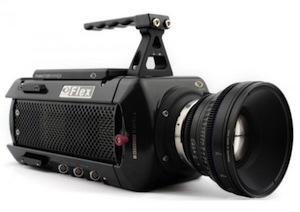
I LOVE the Phantom. Some of you may remember the Famous Footwear spot that I shot with the Phantom Gold – it’s predecessor. I knew then that this was a gorgeous camera and sensor.
Pros: ZERO rolling shutter. Like film. And the Flex’s sensor holds up incredibly well with all of the cameras above – surprisingly so when you consider the camera’s primary focus is on high speed capture – not low light etc. The color, and dynamic range of this camera are impressive in Zacuto’s tests – much much better than what I would have assumed. The low light performance is not quite as spectacular as some of the cameras above – but not that far behind.
Cons: Price is a big factor on this one and the camera isn’t designed to be quite as nimble as many of the cameras above.
V: BIGGEST DISSAPOINTMENT – PANASONIC AF-100
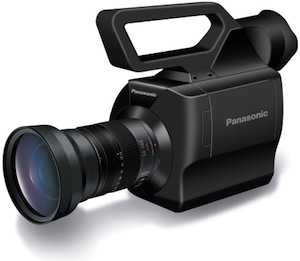
I was so rooting for this camera when it came out. Unfortunately, this camera is a big let down for me. The ergonomics, button layout, endless menus – and most importantly, the image quality – are lacking. The images look like video – chroma issues abound, over-sharpening, very very strange yellow (other) color casts in the highlights… and the kit lenses – ouch. I really have little to say that I like about this camera – it’s one of the first ones that I tried out on a job/shoot- and immediately lost interest. Please note that I am basing my opinion on this camera on BOTH the Zacuto tests and first hand experience with the camera. I’ll go over this in more details in the upcoming blog post I mention above…
VI: TBD – Sony’s F65:
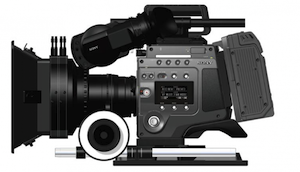
NB: There was no chance to compare this footage side by side with anything else – and no price has been officially set – so the camera is not “rated” per se. But 8K sensor rendering a true 4K image is pretty darn impressive!
Pros: The camera’s image quality was wonderful in the screening room. It wasn’t part of Zacuto’s tests – so I really can’t say much more.
Cons: it’s TBD because no real price has been announced… this camera line tends to get very bulky very quickly as well… how this camera will fare when their F3 is doing such and incredible job is the big question here… other than high end Hollywood productions (see big film/TV Studios) – who is going to buy this camera when the F3 is out there? (People who need 4K and large productions of course.)
VII: Canon HDSLRs – STILL A PLAYER GIVEN ONE FACTOR: PRICE AND AVAILABILITY:

Canon had no camera announcements at NAB this year. There really isn’t much to report on the HDDSLR front at this point. In the Zacuto tests – these cameras were players, not necessarily contenders. The image quality, sharpness, moire issues, and compression definitely weren’t up to snuff with the cameras above – NONE of the cameras above. But if you factor in the price of these cameras compared to all of the systems above, you will understand why 90%+ of users (that aren’t top end productions) will still gravitate towards the Canon HDDSLRs simply because of the affordability, size, and weight of these cameras. While the images were nowhere nearly as pristine as the Alexa, Epic, Phantom or F3 – the quality is still plenty good enough for most, especially when you’re not doing side by side tests like we saw at NAB. Truth is – these cameras are being used consistently on broadcast commercials, television series, and motion picture films. And you don’t have to wait a few months to get your hands on these cameras – which is also a BIG factor for most… More to come soon about all of this – with a much more detailed write up on the Zacuto/Robert Primes test within the next few weeks…
Lastly check out this fun recap from NAB:
[vimeo video_id=”22468436″ width=”700″ height=”400″ title=”Yes” byline=”Yes” portrait=”Yes” autoplay=”No” loop=”No” color=”00adef”]

